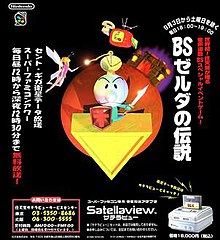
Between August 6, 1995 and May 30, 1999, Nintendo, in collaboration with St.GIGA, broadcast three different The Legend of Zelda titles to fans for download via the Super Famicom's Satellaview subsystem. BS Zelda no Densetsu, BS Zelda no Densetsu: MAP2, and BS Zelda no Densetsu: Inishie no Sekiban all featured SoundLink narration which was the first time that Nintendo-sponsored Zelda titles made use of voice-actors to provide vocal tracks.[nb 1][2] As the first SoundLink Game released via Satellaview, BS Zelda no Densetsu in particular was identified by Nintendo as the world's first integrated radio-game.[3] Also broadcast during this time, starting on March 2, 1997, was a non-SoundLink port of The Legend of Zelda: A Link to the Past, known as Zelda no Densetsu: Kamigami no Triforce in Japan.[4] Broadcasts of Kamigami no Triforce continued periodically throughout the tenure of Nintendo's partnership with St.GIGA (which ended on May 30, 1999), after which St.GIGA independently broadcast the game until May 29, 2000.[5]
With the exception of Kamigami no Triforce all Zelda titles broadcast to the Satellaview were Satellaview-exclusive. Because the Satellaview was only released in Japan, these games were also all Japan-only releases. To date none of these titles have been released in any other form and due to the download limitations imposed on the broadcasts and the termination of support for the system these games are no longer available on the commercial market. Subsequent to the announcement at E3 2010 regarding the rerelease of BS Fire Emblem: Akaneia Senki (the first Satellaview-exclusive title to be re-released commercially) 10 years after the last Satellaview broadcast, there has been renewed[6] speculation regarding the possibility of Nintendo's rerelease of the BS Zelda titles,[7][8][9] but to date there has been no official announcement on the matter from Nintendo.[10]
There has been much fan debate about whether or not the Zelda titles for the Satellaview (collectively known as the BS Zelda games) should be considered enhanced remakes or spin-off titles, whether or not their plots (different plots from the prior titles in 3 of the 4 Satellaview games) should be regarded as canonical or not, and if so where they should fit into the timeline of Zelda events.[11][12][13]
- ^ ファミコン通信. No. 352. 1995.9.15号.
- ^ Uxio, P.R. Historia de Zelda. DSWii.es. 14 June 2010.
- ^ Nintendo (February 13, 1995). BS-X: Sore wa Namae o Nusumareta Machi no Monogatari (Satellaview) (in Japanese) (1995/8/8 ed.). Nintendo/St.GIGA.
Kabe shinbunsha: 8月6日(日)のスタート以来、全国を興奮と感動の渦に巻き込んでいる、世界初のラジオ/ゲーム連動プログラム「BSゼルダの伝説」が大好評につき9月の再放送がついに決定した。
- ^ BS The Legend of Zelda: A Link to the Past. IGN. Retrieved 9 July 2010.
- ^ セント・ギガ衛星データ放送. stgiga.co.jp. 23 June 2000.
- ^ "Epic Center: Zelda from Space?". Nintendo Power. Vol. 94. March 1997. p. 51.
- ^ Une surprise dans Fire Emblem : Monshou No Nazo. VideoJeux. 22 June 2010.
- ^ McWhertor, Michael. Nintendo, Let's Have Great Metroid & Zelda 25th Anniversaries. Kotaku. 28 January 2011.
- ^ Games Inbox: Dark Souls preview, BioShock Infinite, and Duke Nukem's bust. Metro. 15 June 2011.
- ^ History's Hidden Hardware: BS-X (Broadcast Satellaview) / 1995. Nintendo Power. No. 225. February 2008. p.61
- ^ Duncan, Sean C. Literary Implications of Online Fan Debates. Annual Meeting of the American Educational Research Association. March 24–28, 2008. p. 5.
- ^ Sforcina, Mathew. Ask 411Games 06.14.10. 411Mania. 14 June 2010.
- ^ Duncan, Sean C. and Gee, James Paul; Cuddy, Luke (ed). The Legend of Zelda and Philosophy: Chapter 8 - "The Hero of Timelines". Pp 86-95. Open Court. 2008. ISBN 0-8126-9654-9.
Cite error: There are <ref group=nb> tags on this page, but the references will not show without a {{reflist|group=nb}} template (see the help page).